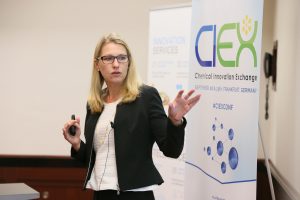

 The director of the Applied Sustainability group of chemical manufacturer BASF, Talke Schaffrannek, recently presented the corporation’s plan, policies and direction of sustainability efforts to BASF employees and associates. In her address at the recent CIEX conference, she explained BASF’s commitment to contributing to a more sustainable model of general economic activity.
The director of the Applied Sustainability group of chemical manufacturer BASF, Talke Schaffrannek, recently presented the corporation’s plan, policies and direction of sustainability efforts to BASF employees and associates. In her address at the recent CIEX conference, she explained BASF’s commitment to contributing to a more sustainable model of general economic activity.
Specifically, the economic model that BASF aims to aide is called the “circular economy”. The concept it relatively simple, and Schaffrannek boiled it down to two central concepts: keep it simple and close the loops. Keeping it simple involves maximizing the efficiency of both product and process, while closing the loops refers to the process of turning waste back into useful resources.
Schaffrannek explained that the Applied Sustainability group at BASF has spent several years categorizing the corporation’s 60,000 products into four different sustainability levels: accelerator, performer, transition, challenged.
The evaluation process says that an accelerator is a leading contributor to the circular economy value chain, a performer follows market standards, a transition product is performing below the market standard, yet actively being resolved, and a challenged product is one whose sustainability concern has been identified, but is not being actively addressed. She says more than 97% of BASF’s products are accelerators or performers.
Evaluation is only half the battle, of course, and Schaffrannek goes on to explain the other half of the battle: implementing new and more sustainable processes and products. In terms of a single product, she explains that the “keep it smart” process is as simple as identifying the challenge, researching and creating an action plan, and launching the superior product.
The “close the loops” process is a little more difficult, she says, because it requires behavioral change for the firm as a whole rather than for a single product. It’s all about streamlining production and eliminating waste. A model which BASF has worked under and continues to follow is called verbund, which requires connecting separate plants to maximize resources.
But that’s not all BASF can and will do to close the loops. Another new business model which BASF now has their eye on is biomass balance. This three step process calls for adding a renewable feedstock to chemical production, using verbund during the production process, and allocating the original renewable feedstock to certain products at the end of product life. It’s a little harder to envision, but she says it essentially requires monitoring of the renewable feedstock throughout the product’s lifespan.
Schaffrannek admits that changing business processes is an arduous task, and implementation could be far off. However, she emphasizes the importance of continuously taking steps forward to develop the circular and sustainable economy within the firm.
The full BASF presentation on “Circular economy: Keep it smart, close the loops” is available to view below:
Editor’s note: The next CIEX conference will be held on Sep 19-20, 2017 in Frankfurt, Germany. Visit: http://www.ciex.-eu.org to reserve your seats!
[adrotate group=”1″]